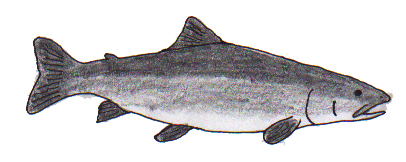 Marshall
Cultural Atlas Marshall
Cultural Atlas
This collection of student work is from
Frank Keim's classes. He has wanted to share these works for others
to use as an example of Culturally-based curriculum and documentation. These
documents have been OCR-scanned. These are available
for educational use only.
Lake Trout
(Salvelinus namaycush)
(Cikignaq)
Lake trout are Alaska's largest freshwater fish
and they are also the largest of the group of fishes known as char.
They have a body shape common to that of trout and salmon. They have
small, light, irregularly shaped spots on a silver-to-dark gray
background, but color varies in different seasons and in different
lakes. The males and females are quite similar. Males have a slightly
longer, more pointed snout than the female.
Lake trout are found north of the Brooks Range but
are not found in lakes of the North Slope lowlands. To the west, they
are found in the Kobuk drainage, but not within 400 miles of the
Bering Strait. Lake trout are common in Bristol Bay lakes and in the
Pacific drainages just south of Cook Inlet.
Lake trout prefer large, deep, cold lakes in which
they spend their entire lives. As the water cools in fall the trout
feel the urge to spawn and the mature fish look for broken rock or
rubble areas typically found along the lakeshore. The spawning act
occurs when one or more males press themselves against a female. The
eggs and milt come out simultaneously. Most of the spawning occurs at
night.
In spring, when the lake is cold, Lake trout are
found near the surface. They feed more voraciously during the spring
and anglers catch more large specimens at that time than at any other
time. The world record catch for Lake trout is 50 inches and 102
pounds in Canada. In Alaskan waters, Lake trout weigh up to 54
pounds. They are caught with bright spinners, spoons, trolling lures,
jigging lures and even pieces of cut fish.
By Jonathan
Boots

Christmastime Tales
Stories real and imaginary about Christmas, Slavik, and the New Year
Winter, 1996 |
Christmastime Tales II
Stories about Christmas, Slavik, and the New Year
Winter, 1998 |
Christmastime Tales III
Stories about Christmas, Slavik, and the New Year
Winter, 2000 |
| Summer Time Tails 1992 |
Summertime Tails II 1993 |
Summertime Tails III |
| Summertime Tails IV Fall, 1995 |
Summertime Tails V Fall, 1996 |
Summertime Tails VI Fall, 1997 |
| Summertime Tails VII Fall, 1999 |
Signs of the Times November 1996 |
Creative Stories From Creative Imaginations |
| Mustang Mind Manglers - Stories of the Far Out,
the Frightening and the Fantastic 1993 |
Yupik Gourmet - A Book of
Recipes |
|
| M&M Monthly |
|
|
| Happy Moose Hunting! September Edition 1997 |
Happy Easter! March/April 1998 |
Merry Christmas December Edition 1997 |
| Happy Valentine’s
Day! February Edition
1998 |
Happy Easter! March/April Edition 2000 |
Happy Thanksgiving Nov. Edition, 1997 |
| Happy Halloween October 1997 Edition |
Edible and Useful Plants of Scammon
Bay |
Edible Plants of Hooper Bay 1981 |
| The Flowers of Scammon Bay Alaska |
Poems of Hooper Bay |
Scammon Bay (Upward Bound Students) |
| Family Trees and the Buzzy Lord |
It takes a Village - A guide for parents May 1997 |
People in Our Community |
| Buildings and Personalities of
Marshall |
Marshall Village PROFILE |
Qigeckalleq Pellullermeng ‘A
Glimpse of the Past’ |
| Raven’s
Stories Spring 1995 |
Bird Stories from Scammon Bay |
The Sea Around Us |
| Ellamyua - The Great Weather - Stories about the
Weather Spring 1996 |
Moose Fire - Stories and Poems about Moose November,
1998 |
Bears Bees and Bald Eagles Winter 1992-1993 |
| Fish Fire and Water - Stories about fish, global warming
and the future November, 1997 |
Wolf Fire - Stories and Poems about Wolves |
Bear Fire - Stories and Poems about Bears Spring,
1992 |
|